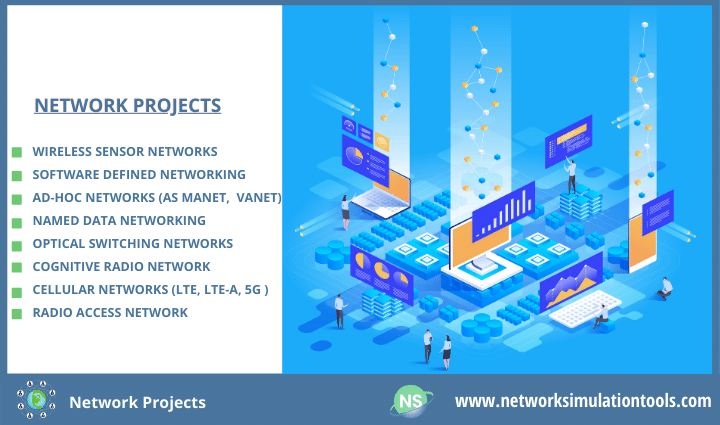Network Projects embraces each nook in the networking arena. In broad, Network defines the group of nodes or hosts or devices connected to share the data. For data sharing, wireless, wired, or optical links are in use. This is the era of wireless networking that has a wide range of cases across various fields. To make it clear, WiFi (IEEE 802.11 series) and Cellular Standards are few samples for wireless techs. In fact, these are the base to connect the devices in the Network.
Besides, Network Projects is a common term that covers more and more types of networks. Based on the features and the purpose, we need to opt for the Network first.
The above are some of the referral fields. To be sure, Network Projects also rely on Hybrid Networks like SD-WSN, Vehicular Sensor Network, and VNDN, etc. Get expert input idea to implement phd projects in wireless sensor network. In the light of networking, it is essential to have some idea of its Elements, Topology, Standards, and Processes.
Of course, each Network has all or some of the above elements. To show a case, MANET will not has the APs or sinks since MANET follows the ad-hoc manner that has no Sink or Base Station.
In the next place, Topology is a vital aspect of any network. To clarify that Topology defines the way in which the Network arranges these elements. The most common topologies include Peer-to-Peer, Star, and Hybrid. Nowadays, it rises to Artificial Fractal, Dragonfly, and so on. After the set up of the networks, it is the time to connect these elements. Here, the communication standards come into the frame.

Besides, each Network uses a set of rules (i.e.) protocols to link with other nodes. In response to this, most of the networks use IPv6 (TCP/IP Suite) protocol. To improve the overall network efficacy, Network Projects often focus on PHY, MAC, and Network layer boost-up. In concern, network processes take a better position. Below, you can find key network processes.
Based on the objective and application of the Network Projects, we can decide the processes. To show, if our objective is to attain Energy Efficiency in WSN, then it is good to have Optimal Routing as well as Duty Cycling. Yet, one can find apt algorithms only after in-depth literature. As a rule, we only use novel algorithms for each network process.
Right now, we are working upon the buildup of the Deep Learning and Machine Learning in networking. As we expect, the next-gen networks will revolve around these techs. If you want more insights on it, then check out the following novel ideas.
As Network is a broad field, we have broad visions on it. You can grab a piece from it as in your needy time. We have 100+ networking pros who are going to shape your work as wise. All of them aim to do an enduring project for you. Are you still in a cynical mind? Then, throw all of your fears by just ring us. Without a doubt, we will convert fill your mind full of wisdom.
| Technology | Ph.D | MS | M.Tech |
|---|---|---|---|
| NS2 | 75 | 117 | 95 |
| NS3 | 98 | 119 | 206 |
| OMNET++ | 103 | 95 | 87 |
| OPNET | 36 | 64 | 89 |
| QULANET | 30 | 76 | 60 |
| MININET | 71 | 62 | 74 |
| MATLAB | 96 | 185 | 180 |
| LTESIM | 38 | 32 | 16 |
| COOJA SIMULATOR | 35 | 67 | 28 |
| CONTIKI OS | 42 | 36 | 29 |
| GNS3 | 35 | 89 | 14 |
| NETSIM | 35 | 11 | 21 |
| EVE-NG | 4 | 8 | 9 |
| TRANS | 9 | 5 | 4 |
| PEERSIM | 8 | 8 | 12 |
| GLOMOSIM | 6 | 10 | 6 |
| RTOOL | 13 | 15 | 8 |
| KATHARA SHADOW | 9 | 8 | 9 |
| VNX and VNUML | 8 | 7 | 8 |
| WISTAR | 9 | 9 | 8 |
| CNET | 6 | 8 | 4 |
| ESCAPE | 8 | 7 | 9 |
| NETMIRAGE | 7 | 11 | 7 |
| BOSON NETSIM | 6 | 8 | 9 |
| VIRL | 9 | 9 | 8 |
| CISCO PACKET TRACER | 7 | 7 | 10 |
| SWAN | 9 | 19 | 5 |
| JAVASIM | 40 | 68 | 69 |
| SSFNET | 7 | 9 | 8 |
| TOSSIM | 5 | 7 | 4 |
| PSIM | 7 | 8 | 6 |
| PETRI NET | 4 | 6 | 4 |
| ONESIM | 5 | 10 | 5 |
| OPTISYSTEM | 32 | 64 | 24 |
| DIVERT | 4 | 9 | 8 |
| TINY OS | 19 | 27 | 17 |
| TRANS | 7 | 8 | 6 |
| OPENPANA | 8 | 9 | 9 |
| SECURE CRT | 7 | 8 | 7 |
| EXTENDSIM | 6 | 7 | 5 |
| CONSELF | 7 | 19 | 6 |
| ARENA | 5 | 12 | 9 |
| VENSIM | 8 | 10 | 7 |
| MARIONNET | 5 | 7 | 9 |
| NETKIT | 6 | 8 | 7 |
| GEOIP | 9 | 17 | 8 |
| REAL | 7 | 5 | 5 |
| NEST | 5 | 10 | 9 |
| PTOLEMY | 7 | 8 | 4 |